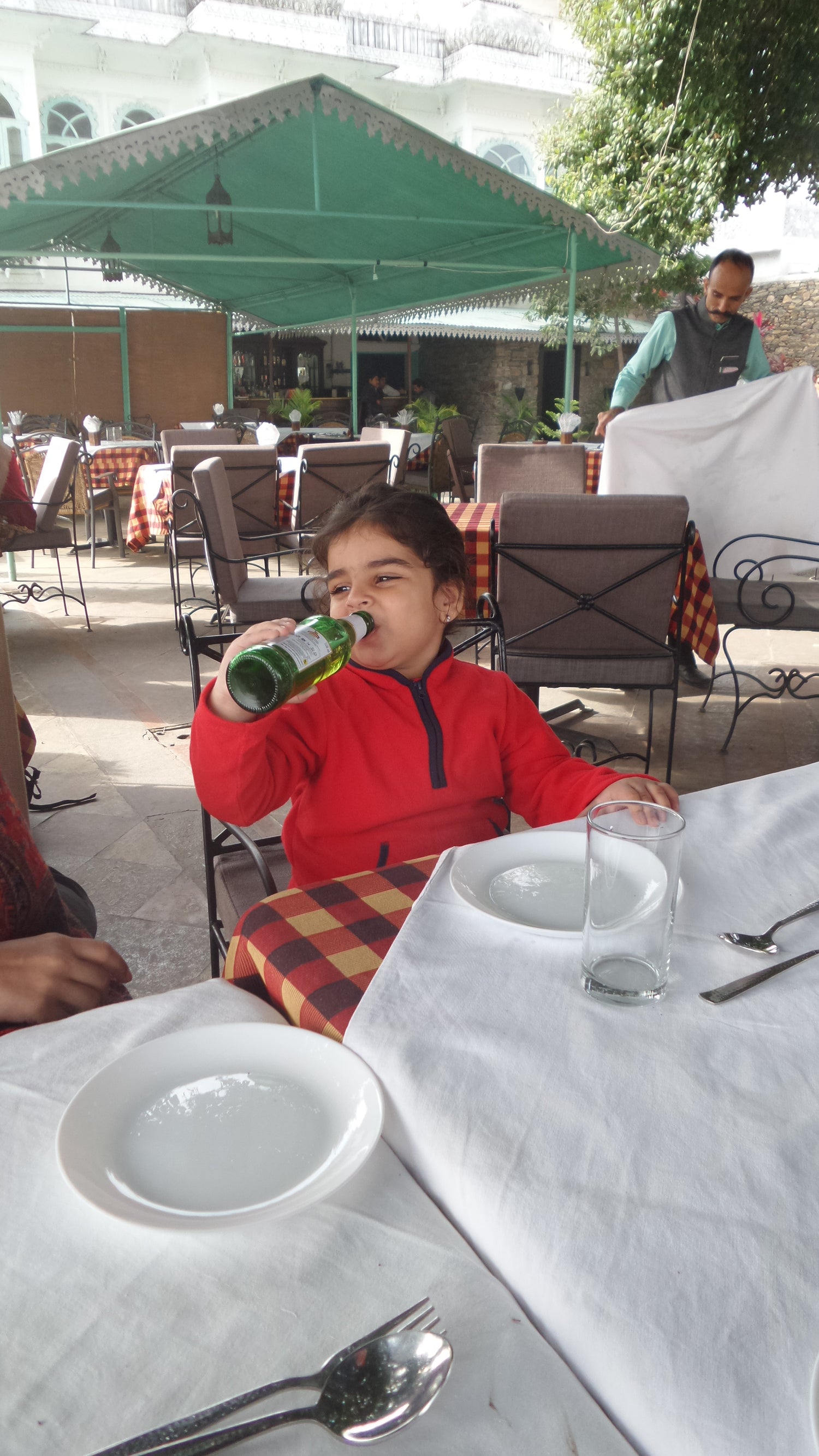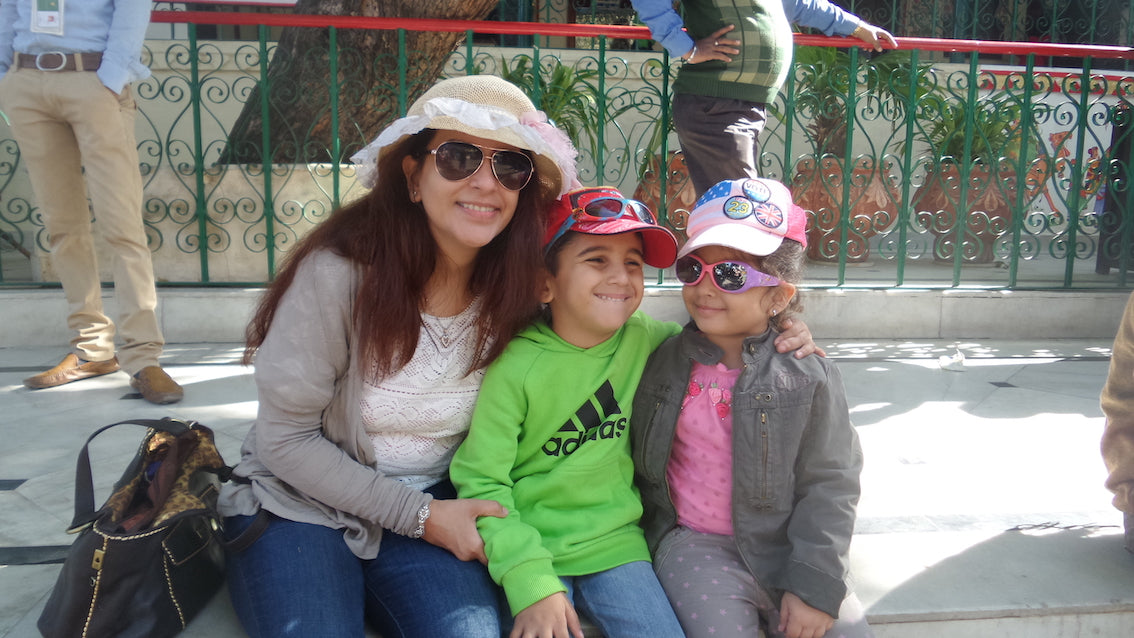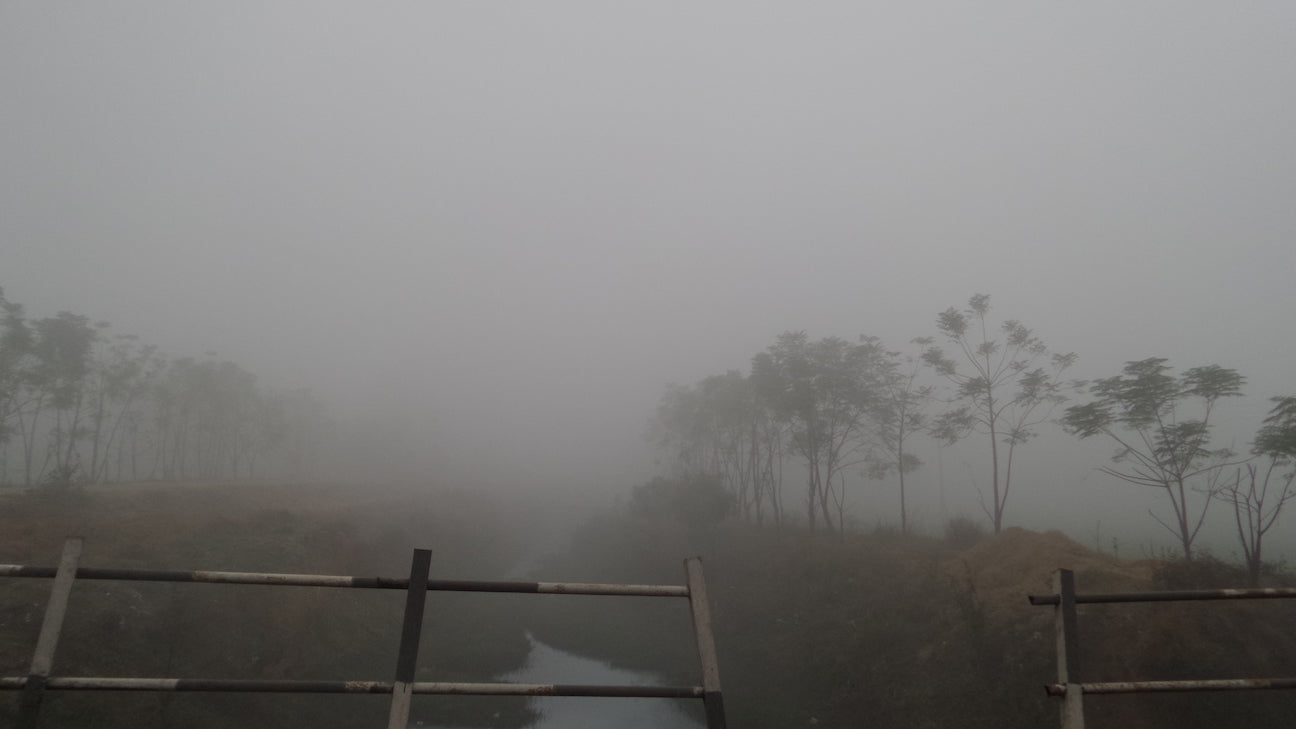Our next halt was more of a break in the journey to Narkanda than anything else. Nevertheless, since we were already there, we figured we should explore Nawalgarh. Apparently, this erstwhile principality has quite a lot to offer to architecture and history buffs!
Udaipur to Nawalgarh roadtrip
We left the Amet Haveli at 0500Hrs the next morning, and in about 10 minutes were onto NH 58. The saga of brilliant Rajasthan roads continued. Coupled with the early morning chill, driving was a bliss. Surprisingly, unlike Maharashtra, Karnataka or Gujarat, there is hardly any traffic on the Rajasthan highways. We made very good time, averaging around 110 Kms to the hour. This was by far the highest we'd done on any of our roadtrips so far.
We drove on past Ajmer without stopping. Around 0900HRS we reached Kishangarh. Here we found a dhaba run by the genial octogenarian, Bade Khan Saab and his son (Chhotay Khan saab, I presume?). It is amazing, that it's 5 years since we did this trip and although I've forgotten the name of the dhaba, I remember the name of the proprietor! Must be due to the interesting conversation we had.
As we walked in I looked up at the proprietor. He was an aged gent. There was a skull cap perched on two bushy eyebrows that merged with a luxurious grey beard. Somewhere in all that hair was a bulbous nose dangling between 2 piercing eyes. I gathered my wits and smiled at him. He confirmed that he had clean toilets for the ladies to use. As for food, he announced in true Henry Ford style that we could have any paratha for breakfast as long as it was aloo paratha.
After freshening up we sat down to some pretty decent aloo parathas with the freshest and most refreshing curd I'd had in a long time. He and I got into a long distance conversation. Long distance, since his counter was quite far from our table and neither of us could be bothered to get up. I learnt his name was Bade Khan Saab. I suspect it's a nom - de - table' he'd assumed.
He seemed rather disappointed that we weren't seeing the Kishangarh fort and launched into an interesting monologue on it's virtues. In his opinion, there was nothing to explore in Nawalgarh!
Apparently, on day the incumbent RanaSa happened to see a sheep defend her lambs from a pack of wolves. Inspired by this, he decided to build a formidable fort here. I guess he didn't have the services of any seer to guide him on strategic decisions like ideal location for fort building etc. Hence he had to look elsewhere for inspiration. Martially inclined sheep are as good as any inspiration, I suppose.
This fort is so formidable that it remains unconquered to this day. It is also home to the miniature style of painting. In fact, the BANI THANI style of painting too originated here. Quite a treasure trove of history, heritage and culture! By now Bade Khan Saab was in his element and nearly apoplectic that we may not visit the fort. I promised we would take a look at it on our way back and he seemed pacified.
He charged us the ridiculously low sum of 120 odd rupees for the breakfast and we were on our way once again. The hospitality and sheer warmth of total strangers never ceases to amaze me!
Just before Kishangarh, one has to turn left onto SH 7, which goes straight to Nawalgarh via Roopangarh and Makrana. For some unfathomable reason Google Maps asked us to continue on NH 48 and we ended up going towards Jaipur! It was still in the general North - Easterly direction, which is where we had to go, but added another 60 Kms to our journey. By the time I realised my folly, we had already traversed 22 of those Kms, and we decided to just go on.
After bypassing Jaipur (where we encountered fair bit of traffic), we got to Govindgarh. By now it was nearly 1300Hrs and everyone had started getting antsy. By my calculation, and if we hadn't taken the longer route, we should've reached Nawalgarh by now. As things stood, we were still about 100Kms away. I stepped on the gas, hoping to get there by 1430Hrs at the latest.
Finally, around 1500Hrs we reached a largish town of sorts and Google showed that we were about 5 minutes from our destination. Following the blue line on the navigation app we passed the town and ventured into the desert. Eventually it announced that we'd reached our destination. Except, when we looked around, all we could see was sand and desolation for miles. Perhaps Club Mahindra was planning to build a property here and we were a couple of years early? Unlikely as that seemed, we back - tracked to the town we'd just crossed.
A helpful passerby told us the place we were in was Jhunjhunu. When he realised we were coming from Ajmer and looking for Nawalgarh, he looked at me like I'd escaped from a mental asylum. "Nawalgarh toh aap 40Km peechhay chhod aye. Wahaan ruk kyon nahin gaye?" was his helpful question.
I quickly backtracked onto the Jaipur - Jhunjhunu bypass road. We'd come along this road earlier and totally missed Nawalgarh. This time, not trusting the map, we simply stopped at every junction to ask for directions. This proved a smart thing to do. By 1615HRS, we arrived at the Roop Niwas Palace, which was the Club Mahindra property!
Roop Niwas Palace, Nawalgarh
Since then I believe Club Mahindra has let go of this property. For whatever it was worth, the Roop Niwas in itself was quite quaint. The weather was decidedly colder. As far as we could see, other than the haveli, there was nothing else around.
Our room was a largish single - storied cottage of sorts, away from the main complex. I assume it must've been an erstwhile outhouse or servants quarter. Irrespective, it was now a very comfortably furnished room with enough space for all of us, and then some! The window opened up to beautiful fields. There was a peacock strutting around right outside our window, completing the picture.

After a quick meal of some roti, dal, chicken, subzi etc., we just lolled around the place. Later that evening, we saw a flock of camels (or is it caravan of camels?) passing outside the haveli walls. Upon investigating, a man happened to be leading them back home. We could only see the tops of the camels from behind the wall. We could seetThe herder only once we went out.
For the sum of 20 rupees he offered us rides on the camels, which Addy and Ritika readily agreed to do. Ranga trusted elephants more and out of a misplaced sense of loyalty refused to have anything to do with camels, or animals that didn't have a trunk.

The rest of the evening was as chilled out as this, it being one of those times when you do nothing and are glad for it! By 2300Hrs we snuggled in to bed against the cold, and passed out looking forward to another day with no agenda and nothing to do, but exist. Other than explore Nawalgarh, of course!
Explore Nawalgarh on foot
Post breakfast the next morning Ritika and I headed off to explore Nawalgarh on foot. It being a lovely winter morning, we decided to walk the couple of kilometres in to town.
About 10 minutes into the stroll we could smell Nawalgarh in the distance. The upside was that we didn't have to ask for directions. The downside was the stench was abhorrent enough to make one gag! Eventually, we got to the main street of Nawalgarh and discovered the reason for the stench. Both sides of the narrow road had an open sewage line running along it.
There were a few halwai shops, hardware stores and general stores, all adding their selfless contributions to the open 'nullahs'. Just in case that wasn't enough, there were a bunch of young dudes hanging around with their uber - cool 110cc bikes in their faux Wranglers (who the hell buys a fake wrangler jean? If you want to fake it, make it Armani!?!), chewing tobacco and helpfully doing their bit to add to the color and decor of the nullah.
One of these dudes pushed up his shades and jumped off his bike on seeing us, 'You explore Nawalgarh? See haveli? I show only 200 rupees'. That made us look up and we realised that the open sewage line wasn't the main tourist attraction of Nawalgarh. The entire main street was lined with ancient 2 storied houses on either side. Most of them seemed deserted, while a few were either occupied or converted to newer and uglier houses. I suppose since they didn't need any long pipes or sewage tanks to be built. Everything seemed to be simply getting discharged onto the street. The guy seemed harmless enough, and we agreed.
I suspect he randomly chose an abandoned house. Considering it wasn't locked (the doors had fallen off), in we went. Nawalgarh is home to some of the country's largest business families, including the Birla, Poddar and Goenka family, amongst others. One look at the open sewer is enough to tell you why they left though. You explore Nawalgarh and can't help questioning the surfeit of havelis on the main street though. Too many mansions for a one - street - town. Doesn't make sense. Till we realised that trade was the reason.
Nawalgarh apparently fell on the crucial overland trade route from the NorthWest and beyond. This was a key point for exchange of goods from Turkey & Persia before they headed further inland either towards Delhi or South towards Gujarat. The design of all the houses bears testimony to this. Our guide helping us explore Nawalgarh could at least explain that much!

As you enter, there is a large waiting hall of sorts. The clerks would meet each visitor here and examine his goods. If he deemed the item to be worthy of the Sethji's time, then the visitor would be ushered to a curtained enclosure on either side of this verandah. Here the Seth (or his brothers, sons, nephews etc.) would himself meet the prospective seller and strike up a bargain. The top of the walls of this outer room were lined with narrow galleries. If there was something that the women of the house may be interested in, they would watch from these galleries. The design is such that they themselves remained unseen. We went up to the galleries. Other than it being a little cramped, the women seemed to have got the better bargain.
As we went further inside, there was another, larger verandah, open to the skies. This space, about 40'x40' was enclosed by a 2 storied structure on 3 sides, with a honeycomb of rooms. None of the rooms were over 300Sq.Ft. big. They were quite gloomy given that only a few had windows. Even these were pretty small and high up near the ceiling. Evidently, looking out (or in) through the windows was not the criteria here.
The ground floor had a small kitchen and an adjoining dry food store or pantry of sorts. The house we were in still had the 'chula' present along with a few old utensils, which was pretty cool. Didn't see any toilets or bathrooms, although I suspect they must've been somewhere. After all, the open sewer couldn't have been feeding itself.
Our intrepid guide soon got bored of our company and asked to be paid. We'd had enough too, so we paid him and wandered off into another of the abandoned houses. The layout was pretty much the same. I suppose it made sense given that pretty much everyone in Nawalgarh existed for the sole purpose of trade.
We headed to check out the Bala Kila, or Nawalgarh Fort. The fort exists only in name, and a hideously ugly structure today houses SBI, HDFC, some sundry other banks and assorted sarkari offices. I don't know which is worse. The Maharashtra government penchant of letting their forts go to neglected ruin or Nawalgarh approach of defacing the fort and turning it into offices!
We headed back to the Roop Mahal, and lazed around for the rest of the day, shoring up our energies for the long drive the next morning. Finally we would be heading to Narkanda and the snow - clad Himalayas!





1 comment
aztnqdemlv
Muchas gracias. ?Como puedo iniciar sesion?
Leave a comment
This site is protected by hCaptcha and the hCaptcha Privacy Policy and Terms of Service apply.